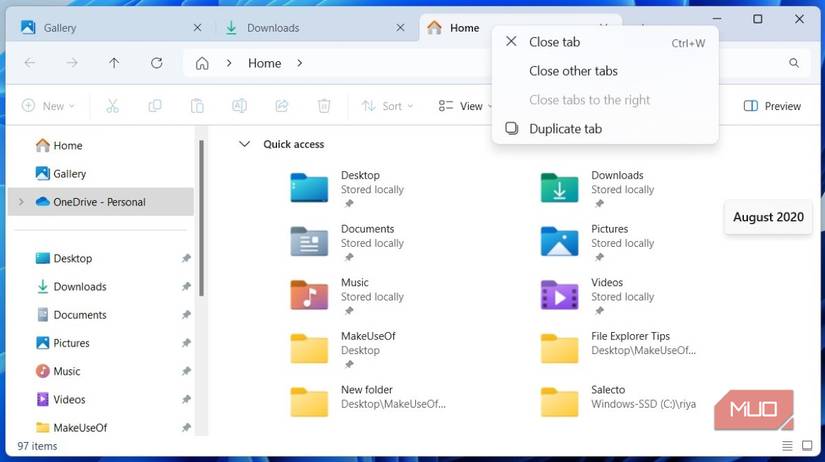File Explorer is something that every Windows user interacts with almost daily. And ever since the release of Windows 11, Microsoft has quietly added features that make managing files faster, more intuitive, and even enjoyable.
File Explorer now feels modern and efficient, with a sleek gallery view for photos and browser-like tabs for managing multiple folders. It connects seamlessly with your phone, supports more archive formats, and even lets you share files without leaving the app. With so many improvements, it’s easy to overlook the smaller yet incredibly useful features that can save you time.
6
Gallery view for photos
A sleek new way to organize your memories
The new Gallery tab in Windows File Explorer brings all the photos and videos on your PC into one place, similar to the Photos app on your phone. When you open it, you’re greeted with large, edge-to-edge thumbnails that make browsing quick and effortless. This way, you can easily spot the right shot instantly without opening a single file.
Everything is automatically sorted by date, so finding that vacation photo from last summer or last week’s project shots takes no time at all. You can even use the File Explorer search bar to pinpoint specific images by name, tag, or metadata.
5
Browser-like tabs
Manage multiple folders without clutter
In late 2022, Microsoft finally added one of the most requested features to File Explorer—tabs. This completely changes how you navigate your files, as you can open multiple folders within a single window and switch between them just like you would between websites in your browser.
In practice, it’s a huge time-saver. You can drag files between tabs, right-click to open a folder in a new tab, or middle-click to close one instantly. It feels smooth, especially if you’ve ever juggled half a dozen Explorer windows just to keep projects organized.
Even better, the same shortcuts you already know from your browser work here too. Press Ctrl + T to open a new tab, Ctrl + W to close one, and Ctrl + Tab to move between them.
4
The Home tab
Your most important files, front and center
Windows File Explorer’s Home tab replaced the classic Quick Access panel around the same time Microsoft introduced tabs. It provides a centralized spot to view your pinned folders, recently accessed files, and even files shared with you.
The Recent tab in the Home tab shows your 20 most recently accessed files, working much like the old Quick Access panel. It’s perfect for quickly reopening a document you were just working on or finding a photo you downloaded earlier. Favorites work as the name suggests. You can right-click any file on your PC and choose Add to Favorites. This way, your most important items are always a click away.
3
Access phone files easily
Browse mobile content without cables
One of the most convenient new tricks in File Explorer is the ability to browse your phone’s files directly from your PC. And no, you don’t need to fumble with cables or sync files to OneDrive.
Once you link your Android device through the Phone Link app, your phone appears in File Explorer just like a regular drive. From there, you can open photos, videos, and documents without even touching your phone or opening any extra apps.
File Explorer treats your phone’s storage as part of your PC’s ecosystem. It’s a game-changer for anyone who spends most of the day at a computer or frequently transfers files. While it’s not quite as fast as a wired connection, it’s more than sufficient for quick tasks like grabbing a photo or sharing a document.
Share files without leaving File Explorer
The Share menu is one of File Explorer’s most overlooked features, but it’s surprisingly powerful. When you right-click a file and select Share, a sleek menu appears with options like Nearby Share, Quick Share, Phone Link, and Email. You can send files to your phone, email a Word document to someone, or share photos with a nearby Windows PC.
For images, File Explorer’s Share menu gives you even more control. While sharing, you can adjust file compression with choices like Low, Medium, or High. Plus, the Windows Share interface includes handy image editing tools. You can crop, rotate, or even add filters before sending, so your files look exactly how you want them.
1
Native archive support
ZIP, RAR, 7Z, and more, all in File Explorer
File Explorer has long handled ZIP archives without breaking a sweat, but earlier, it didn’t offer the same convenience for other popular formats like RAR and 7Z. This meant users often had to rely on third-party apps to open or extract files.
With native support for more archive types, File Explorer now lets you view, extract, and manage a wider range of compressed files directly within its familiar interface. It’s seamless, efficient, and eliminates the need for extra software.
In the last couple of years, File Explorer has caught up with those feature-rich third-party alternatives. So the next time you open File Explorer, take a moment to explore these features. While doing so, you might discover a shortcut, view, or trick that changes the way you organize, access, and share your files forever.




